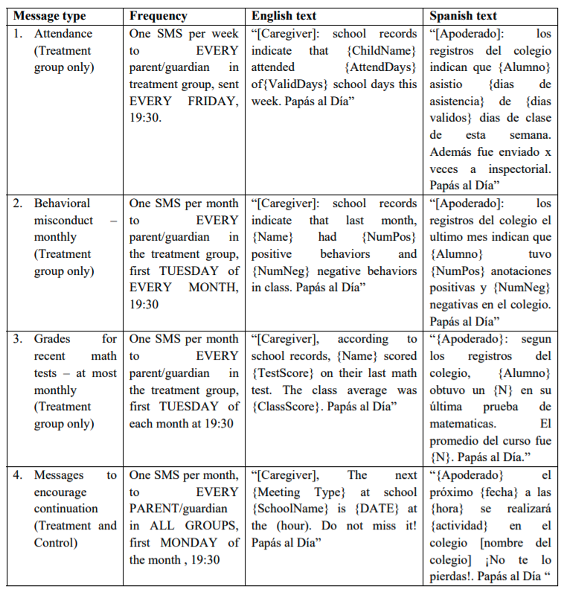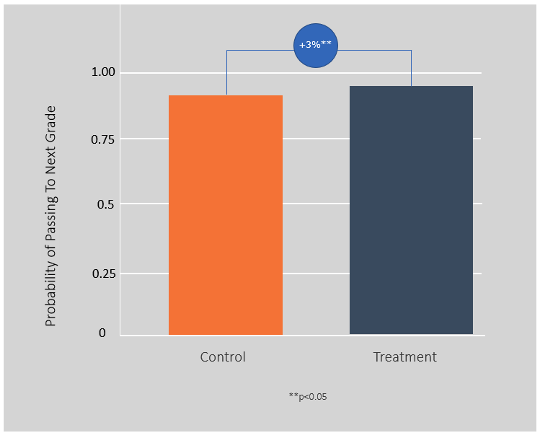Parents up to Date to Improve Children’s School Performance

Context
School dropout and grade repetition are two of the biggest challenges facing education systems in medium-sized countries. In Latin America and the Caribbean, only 46 percent of students graduate from high school on time, and only 53 percent of young people between the ages of 20 and 24 years have completed their studies at this level (UNFPA and ECLAC, 2011). Previous studies have found that school absences, misbehavior, and declining grades are signs of grade repetition and future dropouts.
The Project
This study tests whether communication between schools and parents about student performance could help families improve their child’s school performance.
The randomized experiment was conducted in a sample of low-income Chilean families to evaluate the effects of digitizing existing school records on attendance, grades, and behavior and then communicating this information to parents each week through cellphone text messages (SMS messages). The program was called Papas al Dia, or, “Parents Up to Date.” The experimental sample includes almost 1,500 children enrolled in grades four through eight in eight schools in Santiago.
Behavioral Analysis
Behavioral Barriers
Lack of Information: While schools around the world regularly record student outcomes, families may not have timely access to this information. At best, schools communicate these data to parents using report cards, which may or may not ever reach home.
Cognitive overload: The cognitive load is the amount of mental effort and memory used at a given moment in time. ‘Overload’ happens when the volume of information provided exceeds an individual’s capacity to process it. People have limited amounts of attention and memory, which means they are not able to process all the information available. In this context, parents may forget or overlook information contained in the report cards.
Salience: Individuals tend to focus on items or information that are more prominent and ignore those that are less so. Thus, it is important to make key aspects of messages visible and salient and display them in an appropriate place and time. Report cards may be an unnoticeable document for parents.
Behavioral Tools
Feedback: It is an effective tool to enhance awareness of the consequences of various choices. It may fill knowledge gaps and foster the search for efficient alternatives. In this intervention, SMS were design to give feedback to parents about their children’s behavior on a frequent basis.
Prescriptive norms: These refer to what society approves or disapproves of—that is, what is considered to be right or wrong—regardless of how individuals actually behave. Such norms are useful for reaffirming or encouraging what are considered positive individual behaviors while discouraging negative ones. In the context of our study, the acceptable behavior is to pay taxes when they are due to the government. In this context, the share of schoolchildren treated at the classroom level was varied to test the spillover effect of these norms on parents so they might share information.
Reminders: They can take many forms, such as an email, a text message, a letter, or an in-person visit reminding individuals of some aspect of their decision-making process. Reminders are designed to mitigate procrastination, oversight, and cognitive overload.
Prominence: Human beings have limited stores of attention. Making key elements visible and prominent at the proper time and place is as important as the message itself.
Intervention Design
Parents of approximately 1,500 fourth- to eighth-grade students enrolled in eight schools across Santiago agreed to receive frequent information about their child via text message (SMS). The program required digitizing school administrative records on academic performance and communicating this information to parents via a weekly automated message. The feedback on their child included:
- Attendance (weekly)—how many days during the previous week the child was in school.
- Behavior (bimonthly)—the number of positive, neutral, and negative behaviors teachers recorded in their notes over the prior month.
- Grades (bimonthly)—the three most recent math-test scores of their child and the average of those scores. Parents also received the class average score for the same tests so they could see how well their child performed relative to the class mean.
Parents who consented to participate in the study were randomly assigned to either the treatment group or the control group, and the number of students in the intervention group at classroom level was also randomized (either 25 percent or 75 percent). Those in the control group received normal communication from the schools, including some neutral text messages with general information about school events.
Figure 1. SMS Message Content

Challenges
- Behavioral data were difficult to collect. In Santiago, each classroom has a notebook in which teachers can enter comments on particularly good or bad behaviors of specific students. The team developed a system for categorizing these behavior notes as positive, negative, or extremely negative, and then implemented these definitions in all classes.
- All SMS were sent as planned, but there were issues with delivery and reception. To maximize the chances of reception, delivery was changed from Friday to Monday early on in the intervention. Moreover, all consenting parents were re-contacted in March 2015 to verify and/or update their cellphone numbers, to minimize the chance of message failure.
- Papás al Día is a relatively low-involvement intervention—parents were not instructed in how to interpret or use the information.
Results
The randomized evaluation found immediate results within the first five months, leading up to the end of the first school year. By the end of the year, students in the intervention group improved in many areas compared with the control group:
- Cumulative average mathematics grades were higher among intervention students, and their probability of obtaining a sufficient grade to pass mathematics increased by 2.8 percentage points (relative to an average of 90 percent).
- Probability of their cumulative attendance being greater than the minimum 85 percent required to pass the grade increased by 6.7 percentage points.
- Extremely negative teacher notes on behavior (harassment or verbal and/or physical violence) decreased by 1.3 percentage points.
- As seen in figure 2, the probability of passing on to the next grade increased by 2.9 percentage points.
- Positive classroom-level spillovers effects from the intervention-group students in the same classroom both for grade and attendance outcomes and for the probability of passing the grade, but not for behavior outcomes.
Figure 2. Probability of Passing on to the Next Grade

Policy Implications
The results show that a low-cost, low-touch, feasibly scalable intervention can have an important impact on students’ behavior, with potentially large gains in long-run human capital attainment. Relative to other types of parenting programs, the intervention is relatively low cost and would likely be more sustainable and amenable to scaleup in developing-country settings outside of Chile. Effective use of a technology that improves parent-school communication can improve outcomes, thereby improving the returns to existing school inputs.
This study continued for one and a half years, and the authors observed many outcomes at the monthly level throughout the period of study. The focus of this paper is on outcomes measured five months after treatment. But it remains vital to understand program effectiveness over the medium and longer terms, as parents may become fatigued by the program or assume new parental habits that make the program obsolete.
